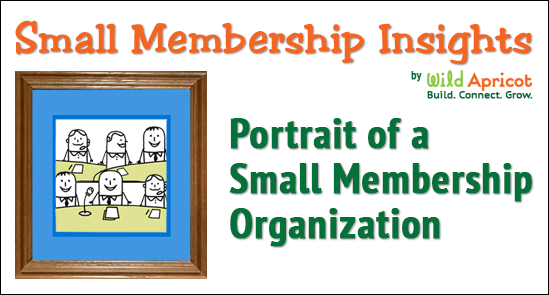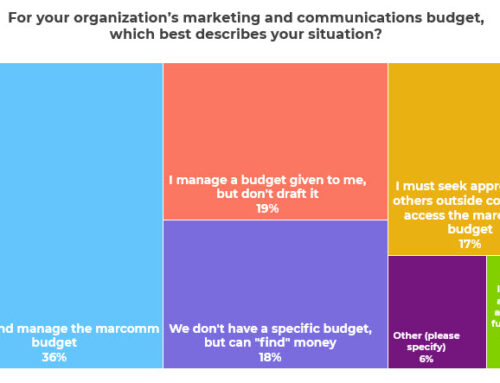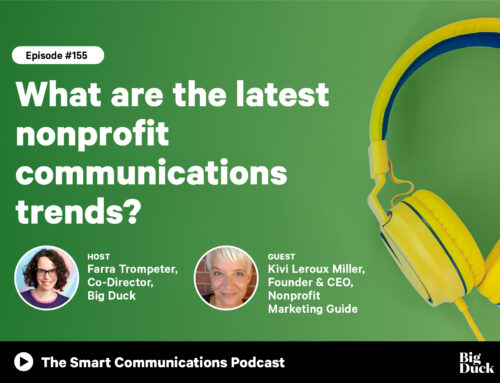
Last month as we released the 2013 Nonprofit Communications Trends Report, the folks at Wild Apricot were in the midst of publishing their Small Membership Insight Survey Report. Their focus on small organizations prompted Lori Halley to ask me to review our data to see how small nonprofits – with annual budgets under $250,000 – compared to our report’s findings overall. That got me wondering if and how the findings of our two survey reports might compare. In this guest post, Lori Halley, Engaging Apricot at the Wild Apricot Blog compares notes on our findings across the two survey reports. ~Kivi
Guest Post by Lori Halley at Wild Apricot
Why our keen interest in small nonprofits?
Since our goal is to help small nonprofits, associations, and clubs build websites, connect with supporters, and grow and manage their membership, we wanted to gain more insight into the world of the small membership organization. We wanted to know more about who manages these groups day-to-day – volunteers or staff; what their priorities are; sources of funding; and much more. So in November we launched the first in what we hope will be an annual Small Membership Insight Survey to gain insight and enable the volunteers and staff of small organizations to share valuable benchmarking information with their peers.
Since the annual Nonprofit Communications Trends Report always provides a wealth of information on communications at organization of all sizes, we didn’t feel the need to focus on communications in our survey. However, we did ask a few questions in order to get a sense of “the current state of membership” for small organizations. So, we were interested to see how our survey findings compared with the Trends Report data.
What did we discover when we compared our two survey reports?
After reviewing the insight on small nonprofits and membership organizations across the two surveys, here’s what we found.
Organizational and communications priorities correspond
When looking at communications priorities, the Nonprofit Communications Trends Report found that size didn’t matter. The findings indicate that organizations of all sizes identified the top three communications goals as: acquiring new donors, engaging their community, and general brand awareness.
We were interested to see that the first two are very closely aligned with the top ranking organizational priorities identified by the small organizations that participated in our Small Membership Insight survey – which were:
- increasing membership
- increasing member engagement
- demonstrating member value
In addition, the Trends Report found that “smaller organizations are more likely than larger ones to also include acquiring new program participants and volunteers as priorities too.” This is understandable given our findings that more than 50% of the small organizations are led solely by volunteers and in fact, have volunteers managing the majority of the day-to-day functions of the organization.
Same tools in the communications toolbox?
While the Trends Report found that, generally, nonprofits large or small identified the top three communications tools as: website, email, and social media (other than blogging).
But in the Small Membership Insight Survey, we found that the communications choices, while similar, changed slightly depending on the audience:
- When communicating with existing members/supporters: email is key channel, followed by websites, and newsletters/magazines
- For renewal efforts: email is #1, websites are #2, direct mail is #3, but phone calls were close behind in 4th place
- For recruitment: websites were the first choice, with word-of-mouth a powerful force in 2nd place, and email rounded out the top three marketing channels
Events play a large role for small nonprofits
The Nonprofit Communications Trends Report found that smaller nonprofits rely more on in-person events than larger organizations, and this is especially true for the smallest groups. 43% of those with budgets under $250,000 ranked in-person events as a very important communication channel, the highest compared to all other budget groups.
This is not surprising, since the Small Membership Insight Survey participants ranked events as the second most “critical source of income” for their organizations, topped only by membership fees which understandably ranked as number one.
What about social media?
Our two surveys were unanimous in finding that when it comes to social media use, “Facebook is still king” for nonprofits and membership organizations of all sizes. But as Kivi noted in her guest post on the Wild Apricot blog, the Nonprofit Communications Trends Report findings did uncover a few interesting differences between smaller and larger organizations in terms of social media use. The Trends Report found that those with budgets under $250,000 are much less likely to say that Twitter is an important social media site for them, but are more likely to say that LinkedIn and Google+ are, compared to larger organizations.
The organizations represented in our Small Membership Insight Survey noted that they are using social media networks for recruitment as well as member communications – with just over 50% of respondents including Facebook in their recruitment toolbox, along with Twitter (25%) and LinkedIn (19.2%). It was also interesting to note the significant role that Facebook is playing in member communications – ranking as the fourth tool of choice for communicating with members (following email, websites, and newsletters/journals).
Want more insight into small membership organizations?
If you’d like to find out more about small membership organizations, beyond their communications approach, you can download your free copy of the Small Membership Insight Survey Report.
You can also check out all of our survey infographics on Pinterest – on the Small Membership Insights Pinboard.

![12 Things You Can Stop Doing Right Now [Infographic]](https://www.nonprofitmarketingguide.com/wp-content/uploads/2025/01/Stop-Doing-2025-Info-hung-up-500x383.png)



